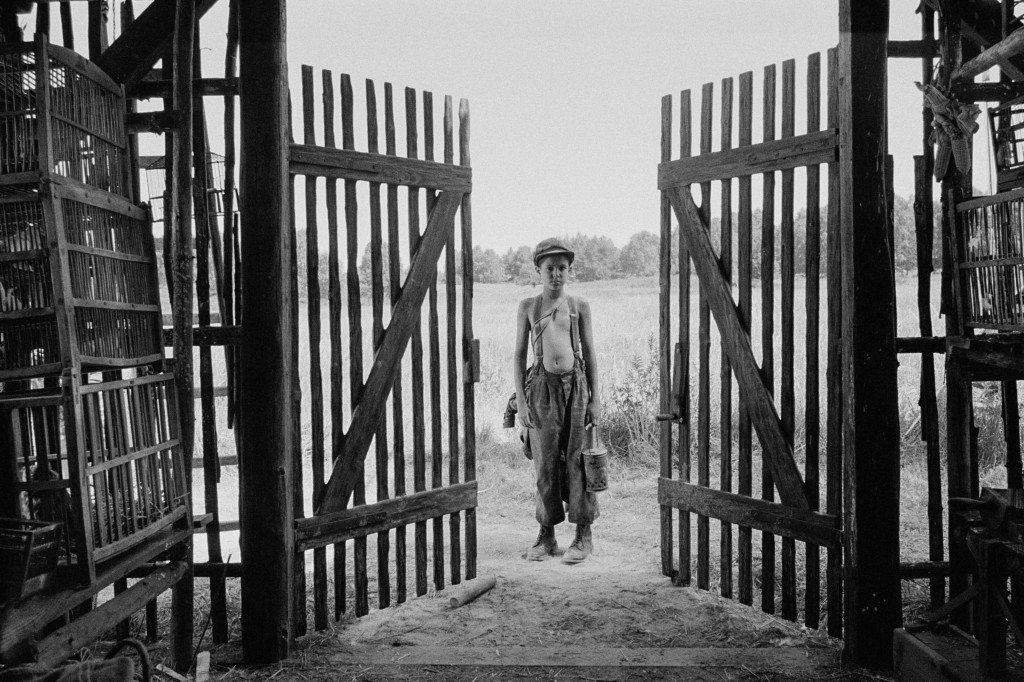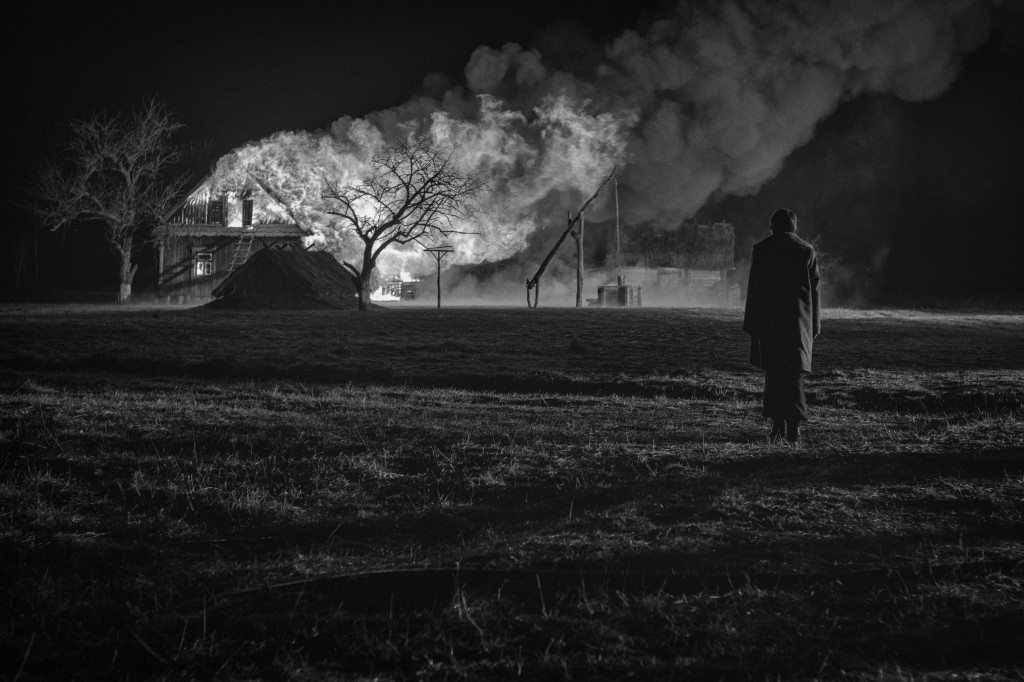“Nabarvené ptáče”, a grisly and unconventional film, with a gloomy and grey atmosphere. It has been a long time since Czech cinema showcased such an original and daring product
The wait was long, but after years marked by conventionality and little risk-taking, Czech cinema once again has aroused international interest and controversy. Just like his compatriot Gustav Machatý, 85 years ago with the scandalous Ecstasy, director Václav Marhoul has also taken advantage of the Venice Film Festival this year to present a work able to shock its public, even to the extent that many of them walked out halfway through its screening, stunned by the brutality and atrocities depicted.
 “Nabarvené ptáče”, or The Painted Bird to use the title for international distribution, based on the novel of the same name by Polish-American writer Jerzy Kosiński, is presented as an evocation of the wildest and most primitive aspects of Eastern Europe towards end of the Second World War.
“Nabarvené ptáče”, or The Painted Bird to use the title for international distribution, based on the novel of the same name by Polish-American writer Jerzy Kosiński, is presented as an evocation of the wildest and most primitive aspects of Eastern Europe towards end of the Second World War.
The Prague-born filmmaker Marhoul has not discarded the barbarity present in the book, which is inflicted primarily upon its young (presumably Jewish) protagonist in the form of hatred, racism, and abuse (even sexual). An uncompromising vision, which as is to be expected, has divided the critics into two camps: those who believe it to be the work of a true visionary and those, on the other hand, who consider the extreme violence gratuitous, even to the point of labelling it “a detestable pornography of misery”, to quote the words of Raffaele Meale, founder of the film magazine Quinlan. But are we genuinely talking about a masterpiece or a mere attempt to shock viewers with gratuitous violence?
It would be impossible to discuss the development of the project without referring to the novel by Kosiński, published in 1965 and included in the list of the 100 best English-language novels from 1923 to 2005 by the American weekly news magazine Time. The book also caused a stir for its rawness, but the controversy did not end there. Beyond the Iron Curtain, it was considered nationalistic and ideologically dangerous. The Poles, in particular, felt offended by the negative portrait of their people. Moreover, even in the West, the author has had accusations thrown at him, in this case of plagiarism. Literary critic Eliot Weinberger was among those who questioned the novel’s authorship, arguing that at the time of the publication, Kosiński could not have written a book in English so fluently. While the persistent doubts concerning the author remain, director Marhoul cleverly managed to avoid the problem of “polonophobia”, choosing to shoot the film in the Interslavic language, one created to facilitate communication between the different Slavic peoples. The filmmaker explained his bold choice in an interview with the Indian newspaper The Times of India: “I didn’t want any Eastern European nation to be associated with the characters. If it had happened, it would have been a problem. Furthermore, this story is timeless and universal”.
The tone of the film is already established in the opening sequence where the protagonist is chased and then furiously beaten by peers, who set fire to the ferret he carried by his side with much affection. It is a premonition of a spiral of violence that develops along similar lines. The child, in order to be protected from Nazi persecution, is entrusted to the care of an old woman, but when the latter dies, he finds himself wandering between villages and farms experiencing first-hand the violence of local farmers and the brutality of Russian and German soldiers.
The title of the film refers to a scene in which a starling with painted wings is killed by his own flock, since once he is in flight he is no longer recognized as part of the group. The child protagonist, played by the superb newcomer Petr Kotlár, represents a human being, who just like the bird whose feathers have been colored, is not accepted by his fellow men.
In the interviews provided to promote the film, Marhoul emphasized how war nullifies civilization and the difference between beasts and men, as both suffer violence, and both ruthlessly cause it. The Painted Bird shows how not only the soldiers and the Nazis were brutal, but also “normal” people, such as peasants, driven by ignorance and naive beliefs caused by superstition or isolation. A pointed observation that refers to the present as much as it does to the past.
 A Czech, Ukrainian and Slovak co-production, Marhoul’s project is indeed a truly unusual one, which does not lack an array of internationally renowned actors, such as Udo Kier (the miller), Harvey Keitel (the Catholic priest), Stellan Skarsgård and Barry Pepper (two soldiers) and Julian Sands (a man who first provides hospitality to the child and then turns out to be perhaps his worst nightmare). Curiously, Keitel on his arrival in Český Krumlov where he would shoot his scenes, was totally unaware of the fact that his lines would not be in English, but in Interslavic, and it was none other than Professor Vojtěch Merunka, one of the creators of the new language, who was called to assist him.
A Czech, Ukrainian and Slovak co-production, Marhoul’s project is indeed a truly unusual one, which does not lack an array of internationally renowned actors, such as Udo Kier (the miller), Harvey Keitel (the Catholic priest), Stellan Skarsgård and Barry Pepper (two soldiers) and Julian Sands (a man who first provides hospitality to the child and then turns out to be perhaps his worst nightmare). Curiously, Keitel on his arrival in Český Krumlov where he would shoot his scenes, was totally unaware of the fact that his lines would not be in English, but in Interslavic, and it was none other than Professor Vojtěch Merunka, one of the creators of the new language, who was called to assist him.
Not even the choice of actors seems random and Marhoul, at times, appears to select the actors based on what they represent for the audience. The director is clearly inspired by Soviet war cinema masterpieces such as Come and See (1985) by Elem Klimov and Ivan’s Childhood (1962) by Andrei Tarkovsky. The lead actor of the former film, Aleksei Kravchenko, appears in The Painted Bird as a Russian soldier, while Barry Pepper became known partly thanks to his roles in war films such as Saving Private Ryan (1998) by Steven Spielberg and Flags of Our Fathers directed by Clint Eastwood (2006).
The international reviews can be divided into two categories: on the one hand there are those who were mesmerized by the splendid black and white photography by Vladimír Smutný, the powerful, eloquent images of a film with an almost total absence of dialogue, while on the other hand there are the critics who believe that the attempt to make a realistic film is strongly undermined by the director’s attempts to shock or disturb the viewer almost as a horror film would, a lack of finesse in the use of violence and a slight smugness. Perhaps it was Xan Brooks, the critic of the British newspaper The Guardian, who best summed up the film with these words: “I can state without hesitation that this is a monumental piece of work and one I’m deeply glad to have seen. I can also say that I hope to never cross its path again”.
All in all, neither group is completely wrong, but it must be said that one aspect of the book and the film is often overlooked. The professor of the University of Warsaw and literary critic Paweł Dudziak, has repeatedly stressed that the book is surreal, a fantasy story, and does not present, or attempt to depict, real world events, and sees a frequent misunderstanding of the book by those who take it too literally. Even in the case of Marhoul’s film, if viewed as a surreal parable of human destiny and as the embodiment of the evil inherent in human nature, we can at least partly justify the extremes which the film reaches.
The Painted Bird is certainly a tough, relentless ordeal, an experience lasting two hours and fifty minutes, and a work destined to divide: you either love it or you probably hate it. We believe that, although it does not lack its flaws and imperfections, it is a fascinating, engaging, daring and original experience that gives hope to those who follow Czech cinema.
by Lawrence Formisano




